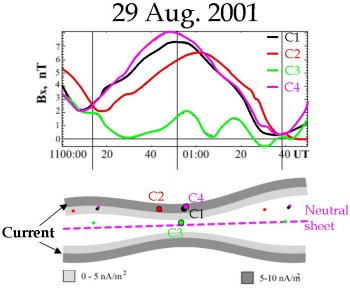Bifurcation of the Tail Current
29 January 2003
The cross-magnetotail current sheet, which separates the northern lobe of the magnetotail from the southern lobe, is one of the key objects of magnetospheric physics.In the simplest 1-D approximation the current sheet has the maximum value in the neutral sheet. However sometimes, the current sheet is perturbed and it can have a maximum on both sides of the neutral sheet. Bifurcated current sheets were observed previously by the International Sun-Earth Explorers (ISEE) (at around 11 Earth radii) and recently by Geotail (at 100 Earth radii).
In a publication in the 17 January issue of Geophysical Research Letters, Runov et al. confirm that with Cluster the bifurcation is also observed at 20 Earth radii. Furthermore, from the Cluster data the speed of the current sheet could also be measured and a wave was observed propagating simultaneously in the dawn-dusk direction.
|
|
|
X component of the magnetic field measured on the four spacecraft (C1 in black, C2 in blue, C3 in green and C4 in red) on 29 August 2001. The shematic view of the current bifurcation is shown on the bottom panel (From Runov et al., Geophys. Res. Lett., 2003). |
The current sheet structure and motion was observed by the FGM instruments onboard Cluster on 29 August 2001. It was found that between 10:55 and 11:02 UT the current sheet moves vertically up and down with a velocity of about 60 kms-1. During this interval the current sheet has a bifurcated structure: electric current is concentrated in two sheets with an extended layer of weak nearly uniform magnetic field in between. After that time, between 11:03 and 11:07 UT the current sheet moves slowly upward and the current sheet has no bifurcation anymore.
Using four-spacecraft timing analysis, Runov et al. show that the fast motion and bifurcation of the current sheet are associated with a wave-like transient propagating in the dawn-to-dusk direction. This wave had a size of 2000 km and was propagating at 200 kms-1. The physical mechanism producing the motion and bifurcation of the current sheet is not known yet. Magnetic reconnection was suggested as a possibility but is not yet adopted.
Runov, A. et al., Cluster observation of a bifurcated current sheet, Geophysical Research Letters, Volume 30, Issue 2, pp. 8-1, CiteID 1036, doi:10.1029/2002GL016136, 2003
